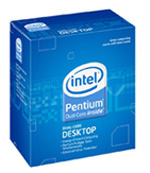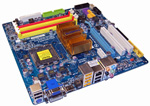Intel HTPC
To be honest, if there's one system in this roundup that is likely to get a lot of comments and criticisms, it's going to be the HTPC configuration. That's not to say that our particular configuration is unreasonable, but in the HTPC market we will invariably encounter a lot of differing opinions about what is necessary and what is not. We detailed our assumptions about the HTPC configurations tin the introduction to the AMD HTPC system. You may want to look back at the considerations. We assume the end user has already selected an HDTV or monitor and a sound system. Very few end users need a TV tuner any more so we are not making that recommendation. We also assume the primary use of the HTPC computer is to play, store, and stream Blu-ray movies and other video entertainment.
| Intel HTPC System | ||
| Hardware | Component | Price |
| Processor | Intel Pentium Dual-Core E5200 Wolfdale (2.5GHz x2 65W 2MB L2 800 FSB) |
$73 |
| Cooling | CPU Retail HSF | $- |
| Video | On-Board | $- |
| Motherboard | Gigabyte GA-E7AUM-DS2H NVIDIA GeForce 9400 | $120 |
| Memory | 4GB DDR2-800 - GSkill F2-6400CL5D-4GBPQ | $37 |
| Hard Drive | Western Digital Caviar Green WD10EACS 1TB SATA 3.0Gb/s Hard Drive - OEM | $105 |
| Optical Drive | LG BD/HD DVD / 16x DVD+/- RW GGC-H20LK | $110 |
| Audio | On-Board | $- |
| Case | Lian LI PC-V350A | $110 |
| Power Supply | PC Power & Cooling Silencer PPCS500 500W ATX12V / EPS12V SLI Ready CrossFire Ready 80 PLUS Certified Active PFC Power Supply - Retail | $50 |
| Base System Total | $605 | |
| Keyboard and Mouse | Logitech Cordless Desktop EX110 Black USB RF Wireless Keyboard & Optical Mouse | $30 |
| Operating System | Microsoft Vista Home Premium OEM | $99 |
| Complete System Bottom Line | $734 | |
 |
As discussed in the Intel entry PC, the E5200 is an excellent value point in the Intel CPU line. Anything lower priced is generally a lot worse in performance, but higher priced CPUs do not gain that much in performance. At the new lower price of $73, the dual-core E5200 is also an excellent match to an NVIDIA 9400 chipset motherboard. It doesn't hurt, either, that the E5200 is rated at 65W, which will help in keeping the HTPC as quiet as possible.
 |
The motherboard for the Intel HTPC is the $135 Gigabyte GA-E7AUM-DS2H featuring the NVIDIA GF9400 chipset. Our motherboard reviews found this chipset and the GF9300 a better choice than G45 in HTPC systems due to superior video playback and overall system performance. Some users have reported that the stock Intel CPU heatsink touches the chipset heatsink on this motherboard and they found the heatsink fit best and worked best by rotating the heatsink 90 degrees. For best results check the fit and best positioning before completing the mount of the heatsink/fan.
 |
The HTPC case is one of those very personal options in building an HTPC computer. Some like the small cube form factor that can easily hide next to books on a shelf, while others prefer the audio component look. While it is fairly expensive for the actual size, we find the cube-like Lian Li PC-V350B a great small aluminum cube. The PC-V350A is the silver version and the PC-V350B is the black version. Both colors sell for the same $110. There is enough space for all the typical HTPC requirements, with good cooling and above all the important blessedly quiet operation. Only a Micro ATX motherboard will fit and there are two 5.25" external drive bays that can open right or left and two internal 3.5" bays for hard drives. Front ports for USB, audio, and FireWire (IEEE 1394) are featured behind a door to keep the appearance sleek and uncluttered. At just 10.3" tall by 11" wide, the V-350A fits in most bookcases just fine, but the depth of 14.7" makes the Lian Li most comfortable on deeper 16" shelves (279mm W x 262mm H x 373mm D).
 |
The little Lian Li is coupled with a robust PC Power & Cooling Silencer 500W power supply that you can currently buy for a bargain $50. You can spend more on a PSU but you will be hard pressed to find a unit as quiet and reliable as the Silencer. It also has enough power for whatever video card you might throw in your HTPC in the future - though high-end GPUs are at odds with the silence most desire from HTPCs.
If you prefer the "audio component" look in your HTPC an excellent alternative is the Silverstone LC13B-E Media Center case selected for the AMD HTPC system. It is worth mentioning that if you choose a full size ATX motherboard for your HTPC, it will fit in the Silverstone but not in the Lian Li cube. The Silverstone is presently on rebate, so the normal $115 price is reduced to $100 after the $10 rebate.
The rest of the components are the same as those found in the AMD HTPC system. For detailed information on the rest of the components chosen for the Intel HTPC please refer to the detailed discussion on the AMD HTPC page.
AMD systems have held the lead for some time in HD video and HTPC boxes. The AMD advantage was large enough that AnandTech hadn't recommended an Intel HTPC build until last December. The NVIDIA GeForce 9300/9400 chipsets have done a lot to level the HD and HTPC playing field - but at a premium price. The Intel HTPC problem was never the CPU, but rather the motherboard chipset. That is the reason we can combine a cheaper Intel CPU with an NVIDIA GF9400 chipset motherboard to create a competent HTPC box.
While we can't tell you HD playback capabilities are completely equal between AMD and Intel today, we can tell you that both HTPC builds provided smooth, stutter-free Blu-ray playback. Certainly that is the primary concern of most HTPC system builders. If you're interested in doing video encoding/transcoding on your HTPC, however, the triple-core Phenom II setup is definitely faster than the E5200; such users would likely want to take a long look at quad-core offerings in all honesty, as encoding is one of the tasks that truly leverage the power of multi-core processors.










66 Comments
View All Comments
JarredWalton - Monday, March 16, 2009 - link
We mentioned the benefits of tri-core for video encoding. Also remember that the latest AMD CPUs are 45nm, while the older non-Phenom chips are dual-core 65nm. I think the tri-core chip may actually be the lower power option at this point - it's certainly not going to be significantly hotter while it will be more powerful. Personally, I'd go for Phenom just to get the updated architecture and other improvements, as the dual-core chips are now based on a design that was state-of-the-art several years back. Until AMD moves the Phenom/K10 base design into dual-core, that will continue to be an advantage of the tri-core and quad-core chips.StormyParis - Monday, March 16, 2009 - link
As you say, it seems AMD has pretty much achieved parity processor-wise, at any given price point except the highest where AMD just really has no product.The MBs for AMD processors are always significantly cheaper than the equivalent for Intel CPUs, which tilts the balance. Why is that ?
Goty - Monday, March 16, 2009 - link
I'm assuming it comes down to the fact that AMD's chipset logic needs to be much less complex than Intel's due to the fact that there is no memory controller. This would allow AMD's chipsets to be smaller, cheaper to manufacture, and cheaper to sell to motherboard makers, thus helping to lower the cost for the end-user.I'm sure this isn't the only reason, seeing as how the actual chipset isn't too expensive either way, but things like the complexity of the PCB needed, the number of surface mount components, etc, probably make up for the rest of it.
just4U - Tuesday, March 17, 2009 - link
Not only that but for the last little while amd has been stuck in the budget bin so alot of the MB's that were popular sellers were in that catagory(manufactuers know whats selling whats not).Jaramin - Monday, March 16, 2009 - link
There are two mistakes in the Intel budget article, in the motherboard section.First, it refers to a E7300 CPU, while the CPU is a E7500. Second, and most important, the motherboard has NO integrated graphics. Either change the mobo, or include an entry level discrete GPU. In any case, you'll have to update the price listing...
mariush - Thursday, March 19, 2009 - link
The AMD Entry Level PC lists:Athlon 64 X2 7750 Kuma 2.7GHz Black Edition (2.7GHzx2 95W 2x512MB L2)
I don't know how they managed to fit 2x 512Megabytes of cache in it...maybe it's KB?
Wesley Fink - Friday, March 20, 2009 - link
Thanks for bringing this to our attention. Now corrected.Wesley Fink - Monday, March 16, 2009 - link
My apologies for the error. We are correcting the error as I type this. The last guide revision did include the Gigabyte GA-E7AUM-DS2H nVidia GeForce 9400, which is a 9400 chipset Integrated Graphics board. However, when it went to post the $120 price and Gigabyte was right, but the description was the non-integrated board from tn\he earlier Budget Guide.The board name and picture are now corrected. The updated description will post shortly.
Jaramin - Monday, March 16, 2009 - link
The price for the motherboard is still wrong. 120$ in the budget system, 135$ in the HTPC, same motherboard.Wesley Fink - Monday, March 16, 2009 - link
You have revealed one of the biggest problems with publishing prices - they change faster than you can post them. We changed the board in the Intel Budget system this morning to the Gigabyte with the nVidia 9400 chipset and used the correct for today $120 price. We had not corrected the Intel HTPS same board which was still showing the previous price of $135. The HTPC price has now been corrected. Hopefully it will remain accurate for a few days.